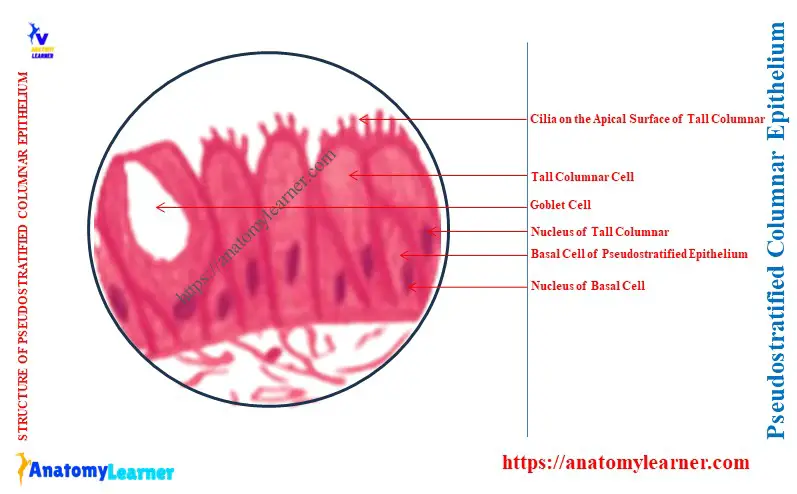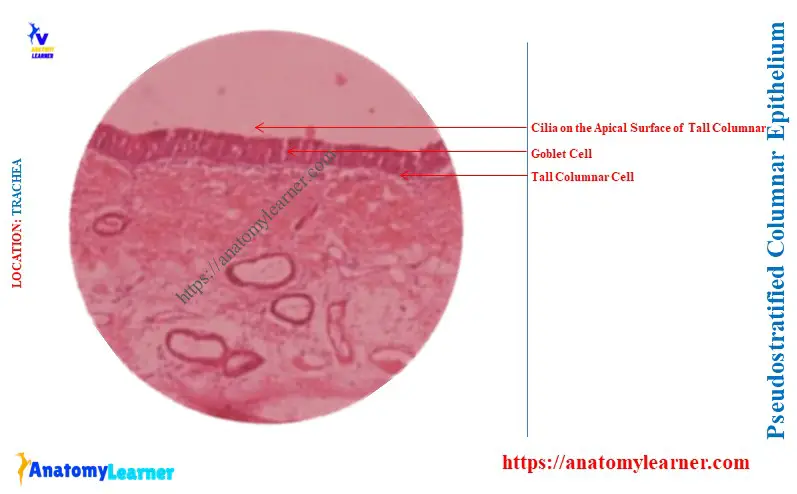The pseudostratified columnar epithelium is distributed in a limited area of the animal organ. Here, you will know the answer to the question – ‘Where is pseudostratified columnar epithelium found’?
Quick answer: the pseudostratified columnar epithelium is found in the lining of the nasal cavity, paranasal sinuses, nasopharynx, trachea, and bronchi. The non-ciliated pseudostratified columnar epithelium is seen in the lining of the ductus deferens and male urethra.
You will also find the pseudostratified columnar epithelium with stereocilia in the lining of the epididymis. Here, I will show the microscopic features of the pseudostratified columnar epithelium from these organs.
Where is pseudostratified columnar epithelium found?
These are not the true stratified epithelium but appear to be stratified under the light microscope. Three types of pseudostratified columnar epithelium are found in the following organs –
- Ciliated pseudostratified columnar epithelium: is seen in the lining of the greater part of the nasal cavity, paranasal sinuses, and nasopharynx. They are also found in the lining of the auditory tubes, trachea, and larger bronchi of the animal’s lungs.
- Non-ciliated pseudostratified columnar epithelium: is seen in some parts of the auditory tubes, ductus deferens, and male urethra.
- Pseudostratified columnar epithelium with stereocilia (larger microvilli): these types of epithelium are typically found in the lining of the epididymis.
The diagram shows the typical features and location of the pseudostratified columnar epithelium from the trachea.

How many layers does pseudostratified columnar epithelium have?
The pseudostratified columnar epithelium consists of a single layer of cells. However, because the cells are irregular in shape and size, their nuclei are located at various levels.
Therefore, this pseudostratified columnar epithelium appears to have several layers. The epithelium cells extend from the basement membrane to the lumen. However, not all the cells of pseudostratified epithelium reach the free surface.

So, the pseudostratified columnar epithelium possesses two major types of cells –
- Short and basal cells: they are short, and they do not reach the free surface of the epithelium and
- Tall and columnar cells: these are the tall columnar cells that rest on the basement membrane and reach the free surface.
You may also find the goblet cells in the pseudostratified columnar epithelium. However, the goblet cells are very organ-specific.
The diagram shows the basal and tall columnar cells from the pseudostratified columnar epithelium.
Are goblet cells found in pseudostratified epithelium?
The goblet cells are found only in the pseudostratified epithelium that lines the respiratory organs. These goblet cells contribute to a thin mucous film over the pseudostratified columnar epithelium. The dust particles in the inhaled air become trapped in this mucus.
But, you will not find the goblet cells in the pseudostratified columnar epithelium that lines the epididymis and ductus deferens.
Here, the diagram shows the goblet cells between the pseudostratified columnar epithelium.

Is the pseudostratified columnar epithelium always ciliated?
Answer: the respiratory organs lined by the pseudostratified columnar epithelium have cilia. These cilia are capable of the movement of the particles.
At some sites, this pseudostratified columnar epithelium does not possess any cilia. They are the non-ciliated pseudostratified columnar epithelium.
You will commonly find the non-ciliated pseudostratified columnar epithelium and male urethra in the lining of the auditory tube.
Some of the pseudostratified columnar epithelium possesses long microvilli (stereocilia). The pseudostratified columnar epithelium of the epididymis possesses the sterocilia.

What are the characteristics of pseudostratified columnar epithelium?
Answer: the identifying characteristics of the ciliated pseudostratified columnar epithelium are –
- The presence of a single layer of columnar cells, but seems to be multilayered,
- The nucleus of the pseudostratified columnar epithelium lies in a row towards the basal part of the cell,
- However, nuclei appear to be arranged in two or more layers, giving the impression that it is more than one cell thick,
- The tall columnar cells of the pseudostratified epithelium possess the cilia,

What is an example of a pseudostratified epithelium?
Answer: the lining of most of the respiratory organs and a few male organs are pseudostratified columnar epithelium. However, the best example of the pseudostratified columnar epithelium is found in the lining of the trachea.
Here, the diagram shows the ciliated pseudostratified columnar epithelium from the trachea. It shows the tall columnar and short basal cells with their nuclei.
These nuclei are at different levels and give a stratified appearance in the lining of the trachea. The diagram also shows the goblet cells in between the pseudostratified epithelium of the trachea.
The higher magnification of the trachea lining will confirm the hair-like projection. These hair-like projections of the pseudostratified columnar epithelium of the trachea are the cilia.
Is pseudostratified columnar epithelium found in the lungs?
Answer: the large or main bronchi that enter the lung are lined by the pseudostratified columnar epithelium. The arrangement of the short and tall columnar cells is similar to the arrangement of the tracheal lining.
Here, the tall columnar cells of the bronchi reach the free surface and possess true cilia. The pseudostratified columnar lining of the bronchi also possesses goblet cells.

You may know more about the histological features of the animal lung from the below-mentioned article –
What is another name for pseudostratified epithelium?
Answer: another name for the pseudostratified columnar of the respiratory tract is the respiratory epithelium. Along with the short, tall, and goblet cells, you will also find some other types of cells in the respiratory epithelium.
The other cells of the respiratory epithelium include –
- Rounded basal cells,
- Columnar brush border cells, and
- Small granule cells,
Pseudostratified columnar epithelium in epididymis
Here, the diagram shows the pseudostratified columnar epithelium from the lining of the epididymis. In this epithelium, the nuclei are located at variable levels and give the stratified appearance.

The epididymis’s basal and tall columnar cells are rested on the basement membrane. Here, the columnar cells reach the surface and possess the stereocilia.
Conclusion
So, the concise answer to the question – ‘Where is pseudostratified columnar epithelium found?” was revealed. The conducting part of the respiratory tract, nasopharynx, and bronchi have the pseudostratified columnar epithelium lining.

